Common Name
Podarcis ionicus
Scientific Name
Podarcis ionicus
Habitat
Podarcis ionicus, commonly known as the Ionian wall lizard, primarily inhabits the coastal regions of the Ionian Islands and certain parts of mainland Greece. This adaptable species favors a variety of environments, including rocky landscapes, temperate forests, and open scrublands. It is often found basking on dry rocks or sunlit surfaces, as this lizard thrives in warm climates. Additionally, Podarcis ionicus can be spotted in agricultural areas and gardens, demonstrating remarkable adaptability to human-altered environments. Its presence is most prominent in regions characterized by Mediterranean climates, where seasonal changes provide optimal conditions for its survival.
Physical Characteristics
Podarcis ionicus is a medium-sized lizard, typically reaching lengths of 18 to 25 centimeters including the tail. Its body is slender with a long tail that can sometimes extend up to twice the body length. The coloration of this species varies significantly across its range; however, it is generally characterized by a striking mix of olive-green to brown hues with dark stripes or spots running along its back. One distinct feature of Podarcis ionicus is its ability to change color slightly to blend into its surroundings, a trait that aids in camouflage from predators. The lizard also possesses a flat head and elongated limbs, making it agile as it navigates rocky terrains and climbs vegetation with ease.
Behavior
The behavior of Podarcis ionicus is notably diurnal, meaning it is most active during daylight hours. This species exhibits territorial behavior during the breeding season, with males often demonstrating displays of dominance through head-bobbing and push-ups. Mating rituals include courtship dances where males display vibrant colors to attract females. While they are generally solitary, Podarcis ionicus can sometimes be seen in small groups basking in the sun, especially during cooler months. They are known for their keen avoidance of predators, utilizing quick bursts of speed to escape and hiding in crevices when threatened. This unique blend of social and solitary behavior adds to the intrigue of studying this fascinating lizard.
Diet
Podarcis ionicus is classified as an insectivore, primarily feeding on a diet that includes various insects such as ants, beetles, and grasshoppers. However, it also displays omnivorous tendencies, occasionally consuming plant matter and fruits when available. The lizard forages actively in its environment, using its excellent vision to spot prey. The dietary habits of Podarcis ionicus are closely linked to its habitat; in gardens and human-altered areas, it often finds ample food sources that support its energetic lifestyle. This species plays a role in controlling insect populations, contributing positively to the ecosystem’s balance.
Reproduction
The reproductive cycle of Podarcis ionicus typically begins in late spring, with a breeding season that lasts until early summer. After mating, females lay between 3 to 8 eggs in sandy or loose soil, which provides optimal incubation conditions. The eggs incubate for approximately 6 to 8 weeks before hatching, with young lizards emerging fully formed. Parental care is not provided; however, the hatchlings are relatively independent from birth. This species has been observed displaying nest site fidelity, returning to the same locations for laying eggs year after year, which highlights their attachment to productive habitats.
Conservation Status
Currently, Podarcis ionicus is classified as of Least Concern by the IUCN Red List. While the species is not facing significant threats at this time, habitat loss due to urbanization and agricultural expansion poses potential risks. Conservation efforts are focused on preserving its natural habitats and raising awareness about the ecological importance of wall lizards in maintaining the health of their environments. Continuous monitoring and habitat protection are essential to ensure Podarcis ionicus remains a thriving component of its ecosystem.
Interesting Facts
One fascinating aspect of Podarcis ionicus is its remarkable adaptability to urban environments, where it can often be seen sunbathing on walls and pavements. Additionally, some populations exhibit unique color variations depending on their specific habitat, which can range from bright green to dull brown. This lizard is known to have a quick reflex response, allowing it to evade predators rapidly, making it one of the agile inhabitants of the Mediterranean landscape. Furthermore, their longevity and ability to reproduce quickly contribute to their resilience in changing environments.
Role in Ecosystem
Podarcis ionicus plays a vital role in its ecosystem as both a predator and prey species. By consuming a substantial number of insects, it helps regulate insect populations, thereby contributing to the balance of the ecosystem. As prey, they provide nutritional support for various predatory birds, snakes, and mammals within their habitat. This ecological interdependence illustrates the importance of Podarcis ionicus in maintaining the health and diversity of its environment. Also, as insectivores, they contribute to soil health through their feeding habits, further emphasizing their role as a keystone species within the Mediterranean ecosystems.
